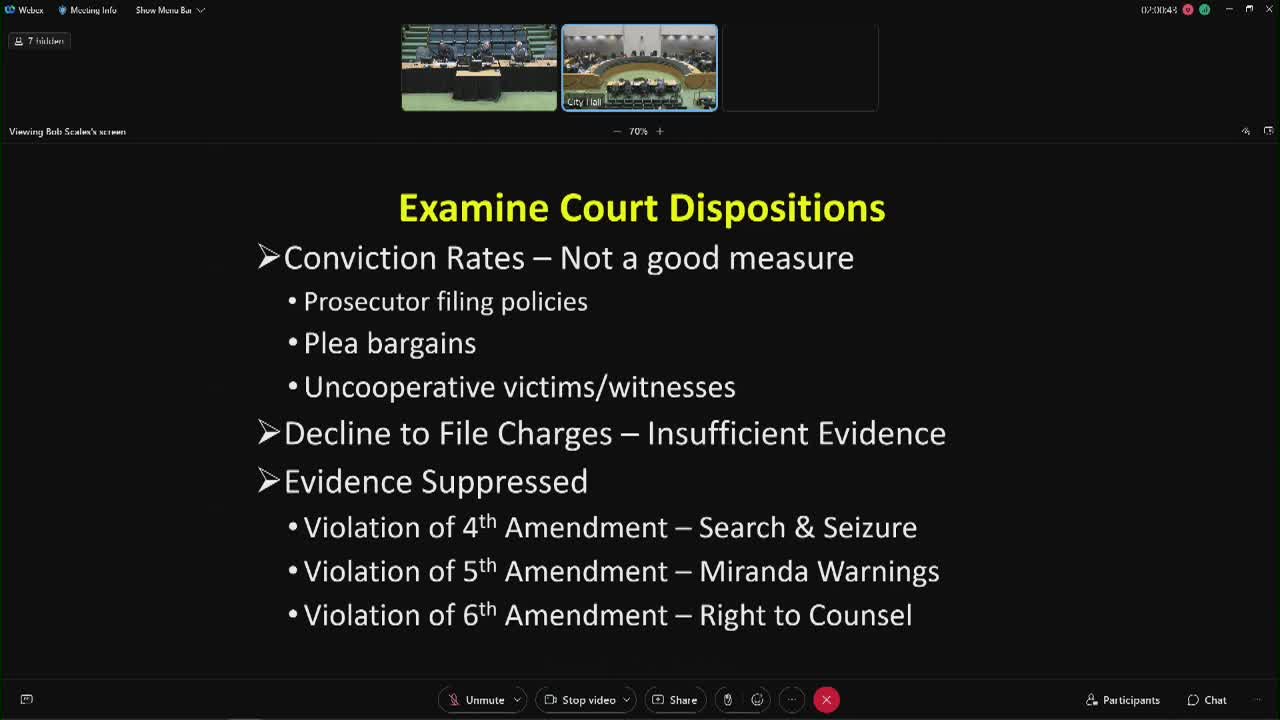Dallas Police Data Analysis Reveals Disparities in Arrests Among Black and Hispanic Communities
January 14, 2025 | Dallas, Dallas County, Texas
This article was created by AI summarizing key points discussed. AI makes mistakes, so for full details and context, please refer to the video of the full meeting. Please report any errors so we can fix them. Report an error »

In a recent meeting of the Dallas Community Police Oversight Board, significant discussions centered around the analysis of arrest data and its implications for policing practices in the city. The meeting, held on January 14, 2025, highlighted the importance of data collection and analysis in understanding the dynamics of arrests, particularly concerning racial disparities.
A key focus of the meeting was the necessity of measuring police activities to manage and improve them effectively. A representative emphasized that actionable data is crucial for both law enforcement and the community. The discussion pointed out that simplistic interpretations of arrest statistics—such as comparing the racial makeup of arrests to the overall population—can lead to misleading conclusions about police practices. Instead, a deeper analysis is required to uncover the underlying issues contributing to disparities in arrests.
The data presented indicated that while there are notable disparities in arrest demographics, there was no evidence of systemic biased policing or racial profiling within the Dallas Police Department. However, the representative acknowledged the complexity of the issue, urging the board to consider various factors, including crime rates and police deployment strategies, when interpreting the data.
The meeting also revealed specific arrest trends in certain zip codes, with areas like 75216 and 75220 showing higher arrest rates. The demographics of those arrested in these areas varied significantly, prompting further investigation into the reasons behind these disparities. The board members expressed a strong desire to delve deeper into the data, emphasizing the need for transparency and thorough analysis to address community concerns.
One board member raised poignant concerns about the implications of high arrest rates among Black individuals, noting that the statistics reflect broader societal issues that affect families and communities. The discussion underscored the urgency of understanding these dynamics, particularly in light of the long-term impacts on youth and community safety.
As the meeting concluded, there was a consensus on the need for ongoing analysis and collaboration between the police department and the oversight board. The board members expressed their commitment to ensuring that the data is not only collected but also utilized effectively to foster trust and accountability within the community. The next steps will involve further exploration of the data and potential adjustments to policing strategies based on the findings.
A key focus of the meeting was the necessity of measuring police activities to manage and improve them effectively. A representative emphasized that actionable data is crucial for both law enforcement and the community. The discussion pointed out that simplistic interpretations of arrest statistics—such as comparing the racial makeup of arrests to the overall population—can lead to misleading conclusions about police practices. Instead, a deeper analysis is required to uncover the underlying issues contributing to disparities in arrests.
The data presented indicated that while there are notable disparities in arrest demographics, there was no evidence of systemic biased policing or racial profiling within the Dallas Police Department. However, the representative acknowledged the complexity of the issue, urging the board to consider various factors, including crime rates and police deployment strategies, when interpreting the data.
The meeting also revealed specific arrest trends in certain zip codes, with areas like 75216 and 75220 showing higher arrest rates. The demographics of those arrested in these areas varied significantly, prompting further investigation into the reasons behind these disparities. The board members expressed a strong desire to delve deeper into the data, emphasizing the need for transparency and thorough analysis to address community concerns.
One board member raised poignant concerns about the implications of high arrest rates among Black individuals, noting that the statistics reflect broader societal issues that affect families and communities. The discussion underscored the urgency of understanding these dynamics, particularly in light of the long-term impacts on youth and community safety.
As the meeting concluded, there was a consensus on the need for ongoing analysis and collaboration between the police department and the oversight board. The board members expressed their commitment to ensuring that the data is not only collected but also utilized effectively to foster trust and accountability within the community. The next steps will involve further exploration of the data and potential adjustments to policing strategies based on the findings.
View full meeting
This article is based on a recent meeting—watch the full video and explore the complete transcript for deeper insights into the discussion.
View full meeting
